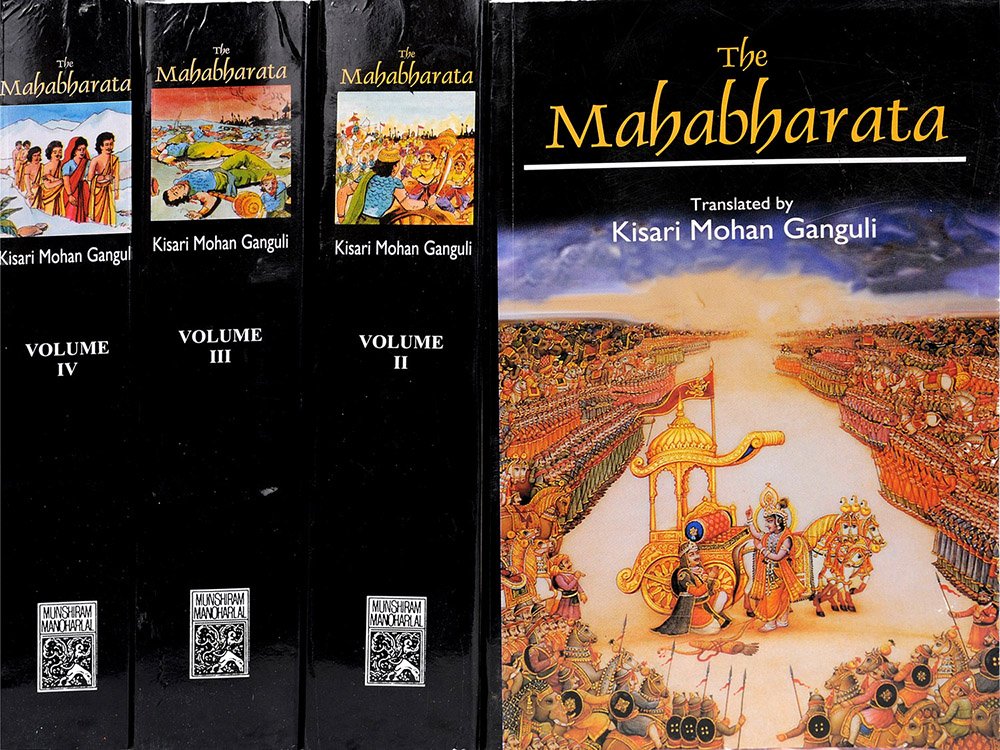Mahabharata (English)
by Kisari Mohan Ganguli | 2,566,952 words | ISBN-10: 8121505933
The English translation of the Mahabharata is a large text describing ancient India. It is authored by Krishna-Dwaipayana Vyasa and contains the records of ancient humans. Also, it documents the fate of the Kauravas and the Pandavas family. Another part of the large contents, deal with many philosophical dialogues such as the goals of life. Book...
Section LXIX
"Uttara said,
'The kine have not been recovered by me, nor have the foe been vanquished by me. All that has been accomplished by the son of a deity. Capable of striking like a thunderbolt, that youth of celestial origin, beholding me running away in fear, stopped me and himself mounted on my car. It was by him that the kine have been recovered and the Kauravas vanquished. The deed, O father, is that hero’s and not mine. It was he that repulsed with arrows Kripa and Drona and Drona’s son of powerful energy, and the Suta’s son and Bhishma.
That mighty hero then spoke unto the affrighted prince Duryodhana who was running away like the leader of a head of elephants, these words,
'O prince of the Kuru race, I do not see that you are safe by any means even at Hastinapura. Protect your life by putting forth your might. You shalt not escape me by flight. Therefore, make up your mind for fight. If victorious, the sovereignty of the earth will be thine, or if slain, heaven itself will be thine.'
'Thus addressed, king Duryodhana—that tiger among men surrounded by his counsellors,—sighing on his car like a snake turned back, showered arrows endued with the speed and force of thunderbolts. Beholding all this, venerable sire, my thighs began to quake. Then that celestial youth pierced with arrows the Kuru army consisting of leonine warriors. And having pierced and afflicted that crowd of cars, that youth, stout as the lion, laughed at them and robbed them of their clothes and attires. Indeed, the six great car-warriors of the Kurus were vanquished by that hero alone, even like herds of animals ranging in the forest by a single tiger in rage.'
"Virata said,
'Where is that mighty-armed and famous youth of celestial origin, that hero who recovered in battle my wealth that had been seized by the Kurus? I am anxious to behold and worship that mighty warrior of celestial origin who has saved you and my kine also.'
"Uttara replied,
'The mighty son of a deity disappeared there and then. I think, however, that he will show himself either tomorrow or the day after.'
"Vaisampayana continued, 'Virata, that owner of a large army, remained ignorant of the son of Pandu who was thus described unto him by Uttara, and who was living in the palace in disguise. And permitted by the high-souled Virata, Partha presented with his own hands the garments he had brought, unto Virata’s daughter. And the beautiful Uttara, obtaining those new and costly clothes of diverse kinds, became highly glad, along with the son of the Matsya king.'"
Conclusion:
This concludes Section LXIX of Book 4 (Virata Parva) of the Mahabharata, of which an English translation is presented on this page. This book is famous as one of the Itihasa, similair in content to the eighteen Puranas. Book 4 is one of the eighteen books comprising roughly 100,000 Sanskrit metrical verses.
FAQ (frequently asked questions):
Which keywords occur in Section LXIX of Book 4 of the Mahabharata?
The most relevant definitions are: Uttara, Kuru, Virata, Drona, Duryodhana, Kurus; since these occur the most in Book 4, Section LXIX. There are a total of 15 unique keywords found in this section mentioned 27 times.
What is the name of the Parva containing Section LXIX of Book 4?
Section LXIX is part of the Goharana Parva which itself is a sub-section of Book 4 (Virata Parva). The Goharana Parva contains a total of 47 sections while Book 4 contains a total of 4 such Parvas.
Can I buy a print edition of Section LXIX as contained in Book 4?
Yes! The print edition of the Mahabharata contains the English translation of Section LXIX of Book 4 and can be bought on the main page. The author is Kisari Mohan Ganguli and the latest edition (including Section LXIX) is from 2012.
